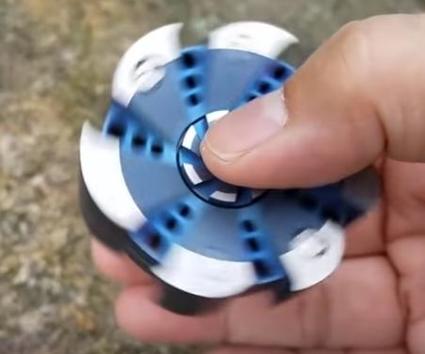 (C) Image - YouTube - Diamond Fidget Spinner Photo link to view the video
(C) Image - YouTube - Diamond Fidget Spinner Photo link to view the video If you have not seen children (and some adults) using the small, spinning toys held in one hand…well, you must have been on a secret Mars expedition for Elon Musk. These three-sided little wonders (yes, some have more ‘blades’ and are large) have been characterized by school districts in a spectrum from the Devil’s plaything to an urgently needed relief for children with ADHD and other distractive disorders. Most parents I have talked with tolerate them and find them valuable for their children…except in some cases where the more expensive ones cost as much as last month’s summer utility bill or even, believe it or not, the cost of a used car. (See the most expensive spinners at https://www.youtube.com/watch?v=-0RIhmATXd8). Luckily, for most people, even $1 versions are easy to find at the local gas pump stations or low cost stores…but their design and safety decreases on the cheaper models.
SafetoLearn is all about safety in school systems, no matter what grade level. Surprisingly, the fidgets are now common in every grade. Even pre-K students have them. This blog will not explore fidget origins or explosive appearance in 2017, but instead propose a balanced view to their use and accommodation.
SafetoLearn is all about safety in school systems, no matter what grade level. Surprisingly, the fidgets are now common in every grade. Even pre-K students have them. This blog will not explore fidget origins or explosive appearance in 2017, but instead propose a balanced view to their use and accommodation.
I remember ten years ago when stress balls started to appear in classrooms. Many school districts forbid their use when some parents complained that teachers were bringing toys into the classroom, and not focusing on teaching. The basis of the problem then, as it is with fidgets now, is management of resources within the teaching space. I heard the same arguments about safety then as I am hearing now about fidgets…that they would be thrown in class, they distracted from teaching and they could be the source of slips and falls. Today the presence of stress balls is so common that most school districts have forgotten about past battles over their use. Many teachers could not survive a class without them as more children fall under the pressures of a driven culture. Besides, if we tried to take away everything in a classroom that could pose a danger in our children’s hands…we would have to take every scissors (even the safety ones), pens and pencils away as well as their cell phones that might set on fire in their backpacks. We would also have to put giant balloon pads around their hands so they didn’t poke, pull, punch, twist and pinch each other. It all comes down to management. We have some ideas to help with that challenge for fidgets to promote classroom safety and discipline.
Teachers with the most success in using these types of stress reducers have followed some basic tenants:
- Set rules early and often regarding a clear definition of use, abuse and consequences
- Students should only use the tools with permission, not open, free choice (including times when child has been under severe stress and requests additional access)
- Select times and places for their use (e.g., only when seated, only during last five minutes of class, etc.)
- Use their use as rewards for good behavior
- Set parameters about sharing
- Consider their use in morning home room with similar guidelines…not open use
- Send guidelines to parents, post them on teacher websites, and post them in the room
- Work towards continuity of guidelines throughout a district, and in each school
The outright banning of fidgets will probably not work. I know this from the many failed bans on food and drinks being present in classrooms, rules against use of profanity by middle school children and warnings about bullying. Prohibitions simply do not work well in a culture where parents discuss at home how they cheated on taxes, stole things from work…or blithely let their children watch them roar through red lights or around school buses when stop arms are out. We exist in an “I can get away with it” society. The best plan is to manage the fidgets in our schools in a productive and useful manner, consistently, as other restrictions will simply result in confrontation and conflict.
As a final note, the fidgets may be a fad—a fancy like mood rings, wrist rubber bands and mullet hairdos. However, in the meantime, they should be properly evaluated for both value and any distraction to the educational process. I can only quote from one school bus driver I know who said, “Yes, I don’t want them flying around while I’m driving, either, but I’ve seen the stress level and bad behavior drop in many students since the fidgets showed up. They know I’ll take them away if they misuse them, or they can be banned off the bus. This year they respected that…and the bus got noticeably quieter, even in the afternoon runs on Fridays.”

 RSS Feed
RSS Feed